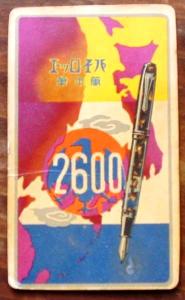


As you can see from the pictures this vintage Pilot eyedropper isn’t in good condition. The once-translucent barrel has ambered so badly that I can’t tell what colour it used to be. There’s also a line that spirals around the barrel, like a toilet roll tube. Perhaps the celluloid was originally a strip that had been rolled into a spiral to form the barrel?
The cap, though retaining more of its translucence, is ambered and cracked. The plastic resembles algae in dirty water ;p It’s a mismatch with the barrel too.

I was curious about the pen’s origins and type of nib. Thanks to Ron Dutcher (Kamakura Pens) and Stan (Ryojusen Pens), I’ve been able to date the pen to around 1940.
– The nib is a Pilot stenographer nib, as indicated by the rectangular breather hole.
– The date code stamped at the back of the nib — 2.40 — indicates it was made in 1940.
– The barrel was most likely made between 1936 and early 1938. It has the “Pilot Pen Mfg…” imprint with the “N” inside the logo.
– The sword clip was made between 1935 and 1954
To illustrate their points Ron and Stan also provided images of advertising cards from Pilot.


Stan’s card led to another curious diversion down darker paths.The “2600” refers to the 2600th year since Emperor Jimmu, descendant of the Sun Goddess Amaterasu, supposedly founded the Yamato dynasty from which the current Japanese imperial family claims an uninterrupted line of descent. This was identified with 1940 in the Gregorian calendar, and that year saw special rituals and events to commemorate this event.
One such event was the unveiling of the Hakkō ichiu tower. Situated at the site of where Jimmu’s palace was supposed to have stood, the tower was the architectural embodiment of the Japanese regime’s expansionist ambitions, fueled by militarist-nationalist beliefs of the Japanese being a divine, superior race via the imperial family.
I was surprised to learn that the tower still stands today in Miyazaki prefecture, even retaining its carved calligraphy of the imperialist slogan Hakkō ichiu. It’s now disingenuously named the “Peace Tower”.


